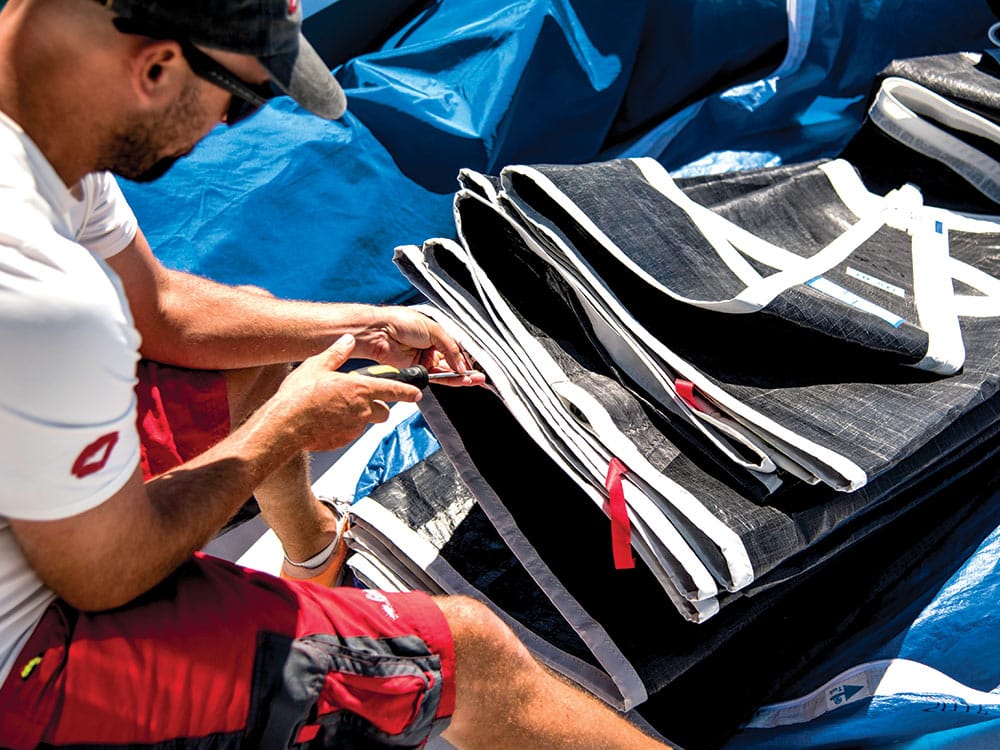
By rule, on a Farr 40, our new sails have to last an entire year. At one Farr 40 event, for example, we won the Mediterranean Circuit using a mainsail that had been used for 132 race legs, a light jib that had been used for 20 upwind race legs and a 1.5-ounce spinnaker that had done 34 downwind race legs. With a full racing calendar, this means we need to do everything we can to keep our sails in the best condition possible. Sails are slower as they age, so it’s critical to keep them young as long as possible. Here’s how we — and you — can get the most out of your sails by simply maintaining them correctly.
First Setup
Be careful removing your new sail from its box, especially if you are using a blade to cut open the box. Nicking any sail is a bad start to its life with you. A little nick in a big white spinnaker could have a disastrous result on the water if it goes undetected until the sail is loaded. If you are opening on a rough surface, lay a tarp first. Even if you don’t mind your sail getting a little dirty (and you should mind!), you will be surprised at how many stitching threads can be damaged by pulling a sail across a parking lot. You don’t want to chafe through stitching that is holding panels together.
If your jib or mainsail battens haven’t been fitted already, be gentle when you fit them. Stuffing battens too tightly into sails (rather than cutting them a little shorter) can put a lot of stress on the soft front ends that are often in the body of the sail, where there is not a lot of structure.
First Sail Check
Allot time to break in your new sail before you race with it. This is not only an opportunity to assess the shape and characteristics of the new sail, but it’s also an opportunity for you to set the standard of care for how you would like your team to treat new sails. In a race situation, we may not have the ability to take as good care of a sail as we can on its first sailing day, so every little bit counts.
Team culture is built around the knowledge that the better we care for our sails, the better our performance will be. When we receive a new jib on a TP52, Maxi 72, or Farr 40, we make it a point not to let anyone stand or sit on any part of the sail. To further reinforce the standard, if we need to check a jib on both tacks, we jibe instead of tack. Of course, the sail will be tacked a lot in its lifetime, but why start now? Every little bit of care counts.
We take extra care when dropping the sails. We’re not in a race situation, so if we can drop a kite or jib gently, we do so. Maybe you sail on a boat that bricks its jibs for racing? Or on the Farr 40, after flaking our jib and zipping up the bag, we fold the sail into thirds. This creates a much smaller package, which can help us centralize weight down below and makes it easier to pull the sail out of the main hatch. However, on a sail-check day with a new jib, we leave the sail long, without folding it into thirds until race day.
Once finished with the day, if at all possible, leave your sails flaked and flat, not bricked or bent or folded more than they need to be, and make sure there is a minimum of weight added on top of them from other sails. Also, avoid leaving them in direct sunlight or in extreme heat.
Race-Day Prep
Minimizing damage to our sails on race day starts with loading sails onto the boat. Don’t drag sails on the ground, over lifelines and stanchions or over deck hardware. If you don’t feel like you have enough people to transfer your sails safely, get more people involved. Get the sails down below as soon as possible, especially if the sun is shining, to protect them from unnecessarily baking in their bags.
We learned a lot about storing sails below deck on the Farr 40. For 18 years I have kept a log of how many legs every sail does every day. This spreadsheet was very helpful, but in the early days, there was an anomaly that we didn’t understand. How was it that the J4 (heavy-weather jib) could look so worn out when it only had three race legs on it?
This prompted us to have a look at what was happening to this sail when it was down below. The J4 was a mandatory sail to have on board for the rules, so it was always down there, even if it was used infrequently. This was when we learned how much damage we were doing to sails in the way we stored them, transferred them to the boat and how we treated them when they were out of sight. As a result, about 12 years ago, I added a new stat on our sail-usage spreadsheet. We now record how many events for which the sail was aboard. A sail that was only used for seven legs might need replacement before a sail that was used for 22 legs if it has been aboard for many more events.
The lesson here is to stack sails in a way that minimizes wear and tear while they are down below. Leave a pathway for the sewer person to get to the front hatch to drop the kite. Make room for someone to get to the back of the boat to clear a traveler line or look through a rudder window. Avoid stepping on the sails when they are not being used, period.
Race Day
When we hoist the mainsail on Bella Mente we always use the engine to back down. This reduces apparent windspeed and therefore results in less angry flapping as the sail goes up. If you have a bolt rope in your mainsail, make sure to guide it efficiently into the groove. If you are pulling the sail up, make sure you can see the sail going into the groove. If the sail gets caught on anything and starts to tear, your quick actions might save the day. This could be the difference between a small repair and a day-ending disaster. The same applies to the first hoist of the jib. Have someone help guide the sail up. The person pulling the sail up should always be looking forward at the pre-feeder.
On the Farr 40, we never tension the jib halyard all the way until we are ready to race upwind. Even inside the starting sequence, we have our jib halyard down a few inches — enough to see big wrinkles — until the final maneuver before the start. The final maneuver could be a tack or a jibe, but the key is that the jib must be tensioned and then allowed to flap or “unload” once before the race starts. If it doesn’t flap or unload after tensioning, it will jump up too much in the first tack off the line, and you will chase your tail trying to get the halyard tension right.
On Plenty, we often tension the jib halyard inside the final 90 seconds of a starting sequence. This might seem laborious, but I have a firm belief that the biggest aging we see in race jibs is the luff being tortured when sailing. Luff tension causes a breakdown in the fiber and film in the front of the sail, so as the sail ages, the draft drifts back. When the sail gets “thin on the entry and deep in the back,” the driver has a harder time driving to the sail, and aerodynamic performance is vastly reduced.
Avoid stuffing the jib down a hatch just because you believe you don’t have enough time for a real flake into a bag. Stuffing a jib with battens is a terrible way to care for the sail. My rule is, make sure that any call to change the jib during the run comes early enough that there will always be enough time to get the old sail into a bag. Another rule is if there is a doubt about how much time there is, go for the bag anyway. You will be surprised how quickly the team can flake and bag the jib under pressure. Stuffing a jib down a hatch should be reserved for true emergencies — not self-imposed time constraints.
Between races, we bag the jib. It keeps the crew from walking over it, and it reduces sun damage. If you have a long delay and have done all of your prestart preparation, drop and bag the jib to give it (and the trimmers) a break, rather than sailing around with it up.
Event Pack-Up
In 1999, in preparation for the 2000 America’s Cup, our team, AmericaOne, had purchased the old OneAustralia boat and its sails for use as a practice boat. The boat and sails had been packed up in 1995 in San Diego and then left in storage. When we opened the sail container, it smelled like the sails had been sitting in water for four years — because they had! At the entrance to the container was a whiteboard sitting on a chair. On it was written, “To the poor bastards who open this sail container, good luck!” The funniest part of all was that our sail loft manager at AmericaOne had coincidentally performed the same role at OneAustralia. He saw the whiteboard and said, “S—t, I wrote that!”
We spent the next several months exploding the old sails one by one, and our sail loft manager tried to put them back together. We all learned a valuable lesson: How you put your sails away at the end of an event can have a huge impact on how quickly the sails age.
When we are putting sails away after an event, we roll the upwind sails, which is the best way to store a laminated sail, provided that, once the sail is rolled, you never bend or fold it. Make sure your technique for rolling, unrolling and flaking does not do more damage than simply leaving them flaked. We also de-tension the battens, but note in our records where the tension was so that we don’t waste time getting back to fast settings.
Putting sails away dry is also very important. Salt water can damage sails and equipment, but fresh water can also be bad for sails in storage. After winning an event in England on Bella Mente, the entire team helped us pack up our sails because we had to finish pack-up that day. It was raining hard — it was England after all — and try as we might, sails were put away in our container, wet with fresh water. When we pulled the sails out of the container for the next event, we were shocked at the level of mold growth. The lesson: If it’s raining hard, try to pull the sails out again as soon as possible to let them dry. This season, on the TP52, we have already made plans to wash and dry our new race sails regularly, making sure that they are salt-free and dry. This will keep our sails on the front line for as long as possible. These new sails are our engines for the season.









